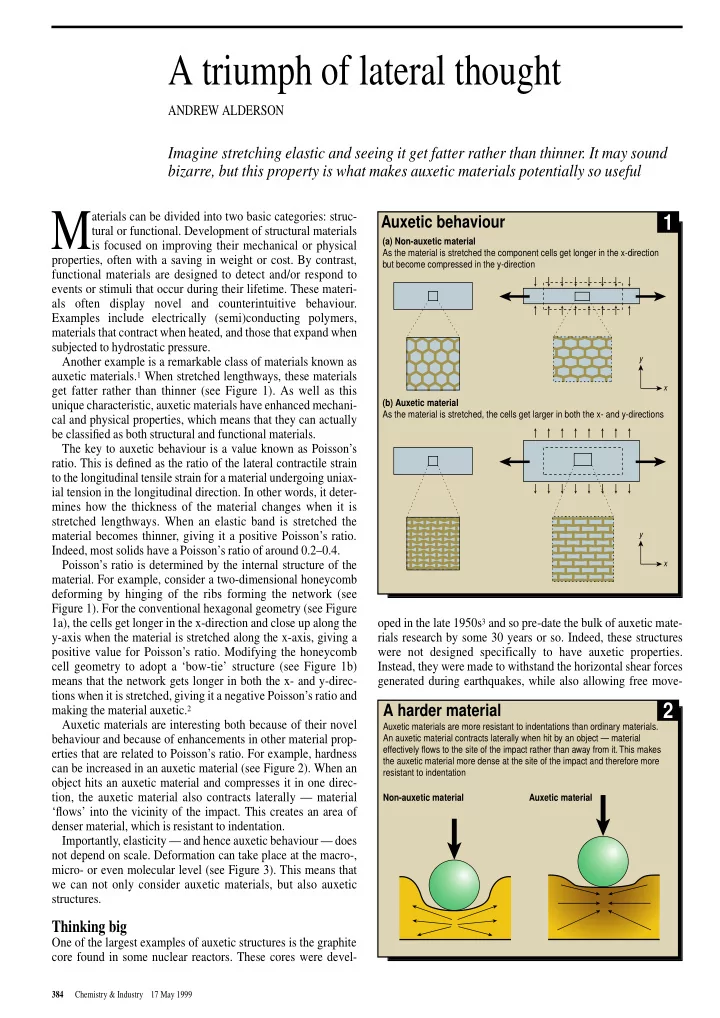

A triumph of lateral thought ANDREW ALDERSON Imagine stretching elastic and seeing it get fatter rather than thinner. It may sound bizarre, but this property is what makes auxetic materials potentially so useful M aterials can be divided into two basic categories: struc- 1 Auxetic behaviour tural or functional. Development of structural materials (a) Non-auxetic material� is focused on improving their mechanical or physical As the material is stretched the component cells get longer in the x-direction� properties, often with a saving in weight or cost. By contrast, but become compressed in the y-direction functional materials are designed to detect and/or respond to events or stimuli that occur during their lifetime. These materi- als often display novel and counterintuitive behaviour. Examples include electrically (semi)conducting polymers, materials that contract when heated, and those that expand when subjected to hydrostatic pressure. y Another example is a remarkable class of materials known as auxetic materials. 1 When stretched lengthways, these materials x get fatter rather than thinner (see Figure 1). As well as this (b) Auxetic material� unique characteristic, auxetic materials have enhanced mechani- As the material is stretched, the cells get larger in both the x- and y-directions cal and physical properties, which means that they can actually be classified as both structural and functional materials. The key to auxetic behaviour is a value known as Poisson’s ratio. This is defined as the ratio of the lateral contractile strain to the longitudinal tensile strain for a material undergoing uniax- ial tension in the longitudinal direction. In other words, it deter- mines how the thickness of the material changes when it is stretched lengthways. When an elastic band is stretched the material becomes thinner, giving it a positive Poisson’s ratio. y Indeed, most solids have a Poisson’s ratio of around 0.2–0.4. Poisson’s ratio is determined by the internal structure of the x material. For example, consider a two-dimensional honeycomb deforming by hinging of the ribs forming the network (see Figure 1). For the conventional hexagonal geometry (see Figure oped in the late 1950s 3 and so pre-date the bulk of auxetic mate- 1a), the cells get longer in the x-direction and close up along the y-axis when the material is stretched along the x-axis, giving a rials research by some 30 years or so. Indeed, these structures positive value for Poisson’s ratio. Modifying the honeycomb were not designed specifically to have auxetic properties. cell geometry to adopt a ‘bow-tie’ structure (see Figure 1b) Instead, they were made to withstand the horizontal shear forces means that the network gets longer in both the x- and y-direc- generated during earthquakes, while also allowing free move- tions when it is stretched, giving it a negative Poisson’s ratio and 2 A harder material making the material auxetic. 2 Auxetic materials are interesting both because of their novel Auxetic materials are more resistant to indentations than ordinary materials.� behaviour and because of enhancements in other material prop- An auxetic material contracts laterally when hit by an object — material � effectively flows to the site of the impact rather than away from it. This makes � erties that are related to Poisson’s ratio. For example, hardness the auxetic material more dense at the site of the impact and therefore more� can be increased in an auxetic material (see Figure 2). When an resistant to indentation object hits an auxetic material and compresses it in one direc- tion, the auxetic material also contracts laterally — material Non-auxetic material Auxetic material ‘flows’ into the vicinity of the impact. This creates an area of denser material, which is resistant to indentation. Importantly, elasticity — and hence auxetic behaviour — does not depend on scale. Deformation can take place at the macro-, micro- or even molecular level (see Figure 3). This means that we can not only consider auxetic materials, but also auxetic structures. Thinking big One of the largest examples of auxetic structures is the graphite core found in some nuclear reactors. These cores were devel- 384 Chemistry & Industry 17 May 1999
Recommend
More recommend